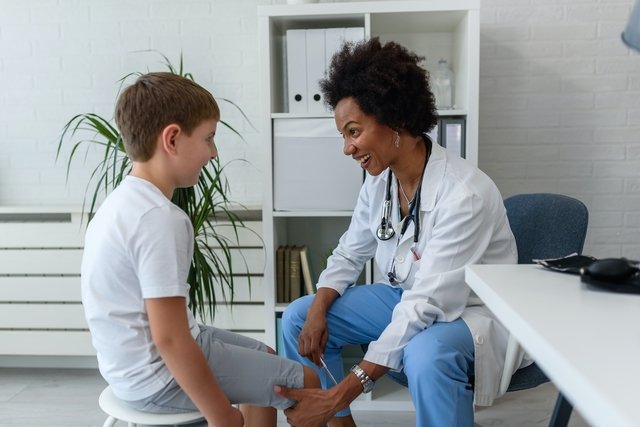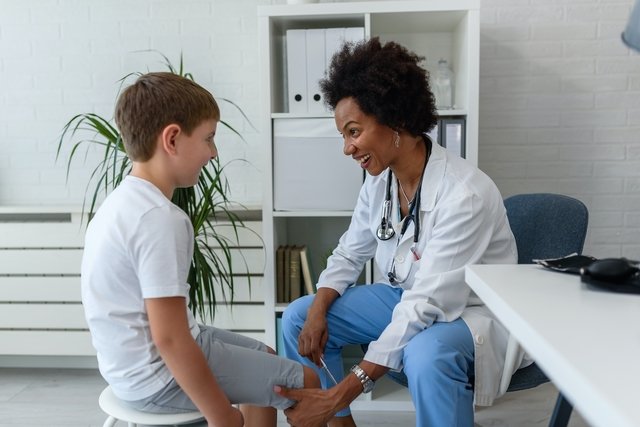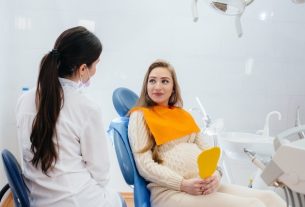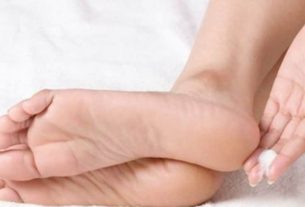Growing pain is a condition that causes pain or discomfort in the legs, which can affect the front of the thighs, the calves or the back of the knees, and usually occurs in both legs, being worse at night, and may wake the child from sleep. sleep.
Generally, symptoms of growing pain do not occur every day and may appear and improve over months or even years. This type of pain can affect boys or girls, from 2 to 12 years old, being more common in girls, and tends to improve after the age of 12.
Although growing pains are not exactly a disease and do not require specific treatment, it is important that the child is consulted by a pediatrician who may recommend the use of medication or physiotherapy to alleviate the discomfort.

Main symptoms
Growth pain can affect both legs and cause pain or discomfort, especially in the late afternoon or early evening, which can affect the child’s sleep, however, the pain disappears in the morning.
The main symptoms of growing pains are pain in the front of the thighs, in the calves or behind the knees, and it is important to consult a pediatrician if the child presents:
- Leg pain that does not improve;
- Pain still present in the morning;
- Pain that interferes with daily activities;
- Sensitivity or increased heat in the affected region;
- Pain in the leg joints;
- Redness or swelling in the affected region;
- Loss of appetite;
- Weakness or excessive tiredness;
- Formation of blisters on the skin of the legs;
- Changes or difficulty walking, as if you were limping;
- Fever, in some cases.
Growing pains can last a few months to years and usually disappear completely once the child’s growth spurt ends.
How to confirm the diagnosis
The diagnosis of growing pains is made based on a physical examination in which the pediatrician evaluates the child’s symptoms and checks whether the legs are swollen, painful or red.
Most of the time, just the physical exam can be enough for the doctor to diagnose growing pains. However, in some cases, the pediatrician may request tests such as X-rays to exclude the chances of other diseases or fractures, for example.
Why does it happen
It is not yet known exactly why growing pains occur, but it is believed that it may be related to excessive activity during the day, such as running or jumping, for example, as they demand a lot from the child’s musculoskeletal system.
Some factors can also contribute to the development of growing pains, such as the child’s age, which is more common in girls aged 2 to 12, or playing sports that involve running, jumping or twisting, such as jogging, football, basketball, volleyball, skateboarding or artistic gymnastics, for example.
You should always consult your pediatrician so that the child’s complaints can be assessed to initiate the most appropriate treatment.
How the treatment is carried out
Generally, growing pains improve spontaneously within one or two years and do not require specific treatment.
However, in some cases, your pediatrician may recommend treatment to relieve pain and swelling in the legs, which includes:
1. Apply hot compresses
Applying warm compresses to your legs can help reduce pain and relax sore muscles.
To make a hot compress, hot water must be added to a thermal bag, which must be wrapped in a clean towel applied to the affected area for 20 to 30 minutes, 2 to 3 times a day.
Additionally, a warm bath can also help relax leg muscles and alleviate growing pains.
2. Get a massage
Massage, done gently, can help relieve pain and discomfort in the legs, as well as causing muscle relaxation and a feeling of well-being, relieving growth pain.
To improve the effect of the massage, you can use a moisturizing cream or almond, coconut or grape seed oil mixed with 2 drops of a calming or anti-inflammatory essential oil, such as lavender or eucalyptus, on the skin. making light, circular movements.
3. Stretch
Stretching is a great option for relieving muscle inflammation and leg pain as it increases muscle strength, improves mobility and flexibility in the lower part of the body and can be done throughout the day to help prevent leg pain. growth at night.
These stretches should be guided by your pediatrician or a physiotherapist.
5. Taking medicine
The pediatrician can prescribe analgesic and anti-inflammatory medications, such as paracetamol, ibuprofen or naproxen, for example.
These remedies must always be recommended by the pediatrician and the treatment time must be individualized, according to the intensity of the pain and the improvement of symptoms.

Sign up for our newsletter and stay up to date with exclusive news
that can transform your routine!
Warning: Undefined array key "title" in /home/storelat/public_html/wp-content/plugins/link-whisper-premium/templates/frontend/related-posts.php on line 12
Warning: Undefined array key "title_tag" in /home/storelat/public_html/wp-content/plugins/link-whisper-premium/templates/frontend/related-posts.php on line 13




